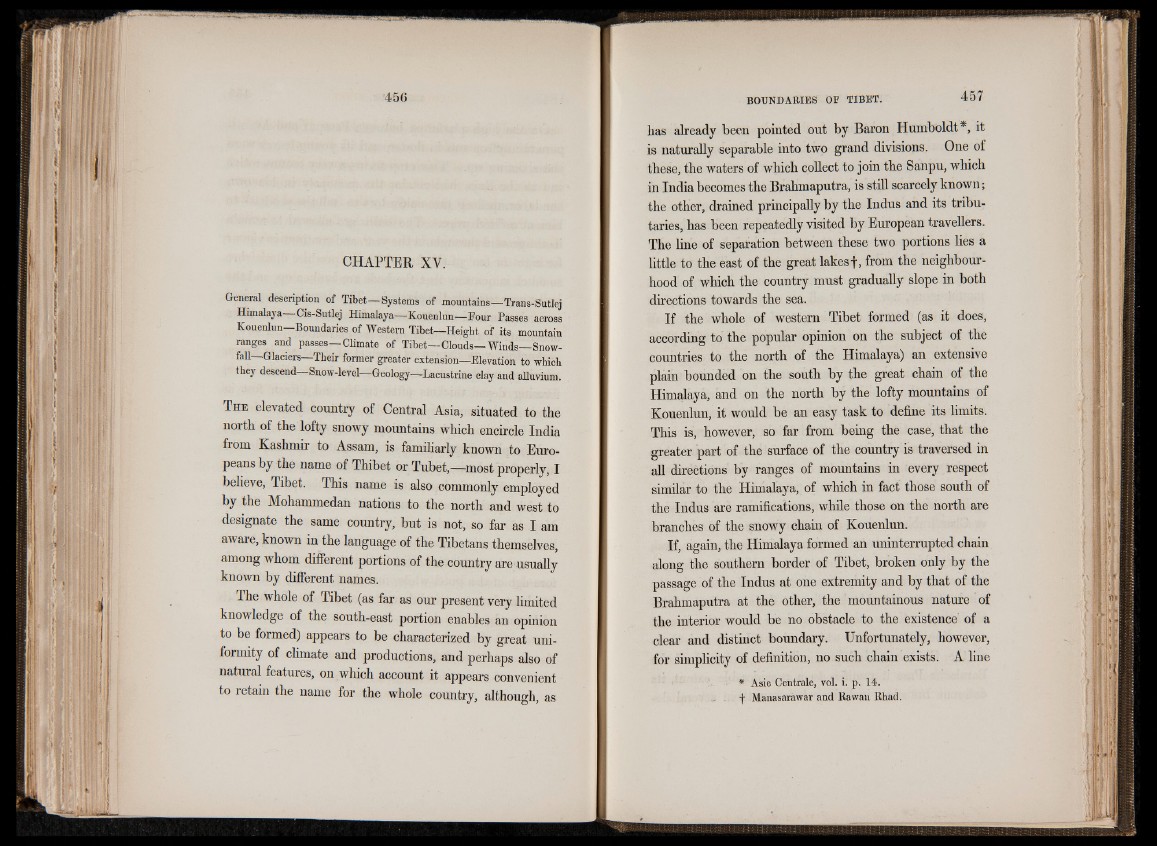
CHAPTER XV.
General description of Tibet—Systems of mountains—Trans-Sutlej
Himalaya— Cis-Sutlej Himalaya— Kouenlun— Four Passes across
Kouenlun—Boundaries of Western Tibet—Height of its mountain
ranges and passes— Climate of Tibet— Clouds—Winds— Snow-
fall— Glaciers—Their former greater extension—Elevation to which
they descend—Snow-level— Geology—Lacustrine clay and alluvium.
T h e elevated country of Central Asia, situated to the
north of the lofty snowy mountains which encircle India
from Kashmir to Assam, is familiarly known to Europeans
by the name of Thibet or Tubet,—most properly, I
believe, Tibet. This name is also commonly employed
by the Mohammedan nations to the north and west to
designate the same country, but is not, so far as I am
aware, known in the language of the Tibetans themselves,
among whom different portions of the country are usually
known by different names.
The whole of Tibet (as far as our present very limited
knowledge of the south-east portion enables an opinion
to be formed) appears to be characterized by great uniformity
of climate and productions, and perhaps also of
natural features, on which account it appears convenient
to retain the name for the whole country, although, as
has already been pointed out by Baron Humboldt*, it
is naturally separable into two grand divisions. One of
these, the waters of which collect to join the Sanpu, which
in India becomes the Brahmaputra, is still scarcely known;
the other, drained principally by the Indus and its tributaries,
has been repeatedly visited by European travellers.
The line of separation between these two portions lies a
little to the east of the great lakes f, from the neighbourhood
of which the country must gradually slope in both
directions towards the sea.
If the whole of western Tibet formed (as it does,
according to the popular opinion on the subject of the
countries to the north of the Himalaya) an extensive
plain bounded on the south by the great chain of the
Himalaya, and on the north by the lofty mountains of
Kouenlun, it would be an easy task to define its limits.
This is, however, so far from being the case, that the
greater part of the surface of the country is traversed in
all directions by ranges of mountains in every respect
similar to the Himalaya, of which in fact those south of
the Indus are ramifications, while those on the north are
branches of the snowy chain of Kouenlun.
If, again, the Himalaya formed an uninterrupted chain
along the southern border of Tibet, broken only by the
passage of the Indus at one extremity and by that of the
Brahmaputra at the other, the mountainous nature of
the interior would be no obstacle to the existence of a
clear and distinct boundary. Unfortunately, however,
for simplicity of definition, no such chain exists. A line
* Asie Centrale, vol. i. p. 14.
f Manasarawar and Hawaii Rhad.